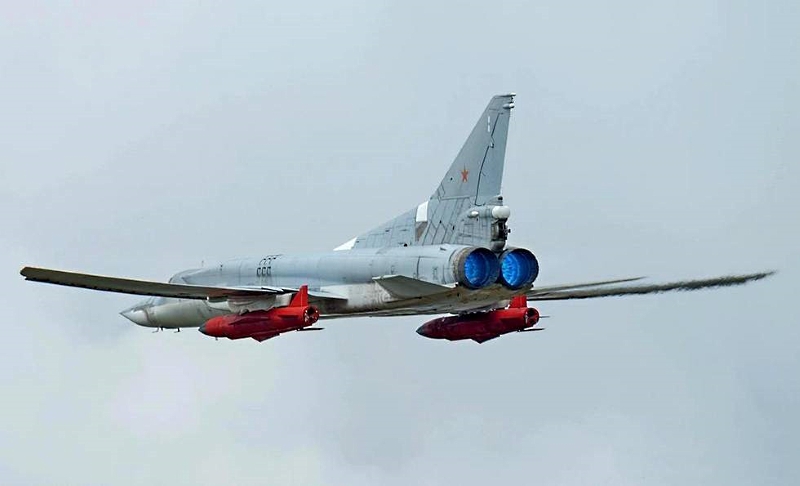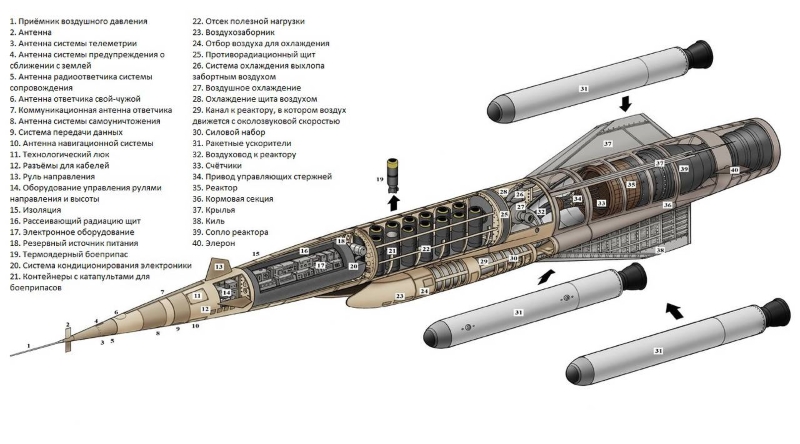Sensational military technologies for the space future
In yesterday’s address to the Federal Assembly, Vladimir Putin announced sensational information about Russian military projects. And the most remarkable thing about them is that, in addition to solving today's task of preventing a nuclear conflict, the technologies implemented can very seriously help the space program of the future.

Tu-22M3M with Kh-32 missiles, photo interpolit.ru
The main news, in my opinion, was the announcement of a cruise missile with a nuclear power plant.
')
Technically, an atomic power plant on a cruise missile can be implemented in one of two options. In the first case, the reactor generates electricity, which is transmitted to the engine, rotating the blades, causing the rocket to move. In the second case, an air-jet engine is used — air is fed into the reactor, heated there and thrown out, creating thrust. Is it possible to determine which option is chosen?

Frame from video
If this frame is from a real flight recording, which is very likely, given the visual difference with simple computer graphics in other parts of the video, the designers have implemented the second option - the fan with an electric motor should not smoke. And, it turns out that the project of sixty years ago is being revived at a new technological level.

SLAM, drawing Damon Moran, translation topwar.ru, full size
From 1955 to 1964 in the United States developed a supersonic low-altitude SLAM rocket with a nuclear ramjet air engine. It was created to complement the fleet of bombers and to act as a possible alternative to the newly designed intercontinental ballistic missiles. In SLAM, they were going to implement several advanced technologies at that time. In order not to get on the radar screens, the rocket had to move at a low altitude. The guidance system would be protected from interference by the fact that it had to work completely autonomously on the map of the relief. And interception would make it difficult to move at supersonic speeds. Conventional fuel to fly in this mode would be spent very quickly (remember that the most economical is the movement at subsonic speed and high altitude, as passenger liners fly), it was necessary to look for an engine with greater autonomy. And as such they suggested using a nuclear jet engine. The resulting design would have several damaging factors at once. The main payload was assumed to be 16 thermonuclear charges of one megaton, dropped over targets defined in the flight program. In addition, the movement at supersonic and low altitude generated a shock wave that damages everything along the route. The engine exhaust was radioactive, and the reactor itself was noticeably "fonil", additionally infecting the terrain. And finally, after the program was completed and all the bombs were dropped, the rocket had to crash at a strategic point, scattering highly active reactor fragments there.
To create the engine in 1957 launched the project "Pluto". In order for the engine to work, many complex tasks had to be solved, for example, at a working temperature of 1400 degrees, the existing alloys became too weak, they had to learn how to use ceramics with beryllium and zirconium. The materials worked at the limit, for example, the auto-ignition temperature of the reactor elements was only 150 ° above its operating temperature. In 1961, the first version of the Tory-IIA engine successfully worked for a few seconds.

Tory-IIA, US Federal Government photo / Wikimedia Commons
In 1964, the Tory-IIC version successfully ran for five minutes at full power of 513 megawatts. To simulate the conditions of supersonic flight, we had to assemble a separate installation and supply air to the reactor, preheated to 500 degrees and compressed to 20 atmospheres.

Tory-IIC, US Federal Government photo / Wikimedia Commons
But then the project stalled at once for several reasons. First of all, even though the engine exhaust was less radioactive than expected, it was difficult to find a suitable area for testing. Also, over the past years intercontinental ballistic missiles were mastered, which turned out to be simpler, cheaper and cleaner than SLAM. And finally, the politicians considered the project too provocative and did not want the USSR to create similar missiles in response. As a result, in the summer of 1964 the project was closed. But his achievements did not disappear - the guidance system on the map of the area became the standard for cruise missiles, and the materials created were useful in solving other problems.
Let's go back to modern times. Compared to Tory reactors, Russian development is striking in its compactness. Vladimir Putin compared the size of the rocket with the X-101, which according to public information has a diameter of 74 cm. For comparison, the SLAM reactor had a diameter of one and a half meters. Also, the initial mass of the X-101 is estimated at 2 tons, and SLAM - at 20 tons.
Radioactive exhaust makes it impossible to use such missiles outside the global nuclear war scenario, when the ecology will not give a damn to everyone, but in space a compact reactor will be extremely useful. For example, you can take a working body with you and get an upper stage with a high specific impulse, similar to NERVA or RD-0410 . Since the nuclear reactor before launch is fairly clean, it can be put on existing missiles, equipped with a shell in case of an accident, and included in space. Further, the concepts of vehicles flying in the atmosphere of other celestial bodies become real. For example, there is a project MITEE (MIniature ReacTor EnginE - a miniature atomic engine) for flying in the atmosphere of Jupiter. Until today it was a purely paper idea, but now it turned out that mankind has an engine that is potentially suitable for such an interplanetary probe.

Slide from MITEE presentation, source
Three other projects concerned hypersonic devices - warheads for the Sarmat intercontinental ballistic missile, the Avangard maneuvering warhead and the Dagger aviation complex.
The development of these systems suggests that the laws of motion at hypersonic speed are becoming increasingly clear. And this knowledge brings the creation of hypersonic lower stages, similar to the unrealized Soviet project "Spiral", and the revival of the concept of air launch launch vehicles.
The first satellites launched minimally converted combat missiles - an intercontinental ballistic missile R-7 from the USSR and a Juno carrier assembled on the basis of the Redstone medium-range missile and Sergeant military missiles in the United States. Secret military technology today in 10-20-30 years will be available for civilian use and will move including the space progress of mankind.

Tu-22M3M with Kh-32 missiles, photo interpolit.ru
Return of "Pluto"?
The main news, in my opinion, was the announcement of a cruise missile with a nuclear power plant.
')
Technically, an atomic power plant on a cruise missile can be implemented in one of two options. In the first case, the reactor generates electricity, which is transmitted to the engine, rotating the blades, causing the rocket to move. In the second case, an air-jet engine is used — air is fed into the reactor, heated there and thrown out, creating thrust. Is it possible to determine which option is chosen?

Frame from video
If this frame is from a real flight recording, which is very likely, given the visual difference with simple computer graphics in other parts of the video, the designers have implemented the second option - the fan with an electric motor should not smoke. And, it turns out that the project of sixty years ago is being revived at a new technological level.

SLAM, drawing Damon Moran, translation topwar.ru, full size
From 1955 to 1964 in the United States developed a supersonic low-altitude SLAM rocket with a nuclear ramjet air engine. It was created to complement the fleet of bombers and to act as a possible alternative to the newly designed intercontinental ballistic missiles. In SLAM, they were going to implement several advanced technologies at that time. In order not to get on the radar screens, the rocket had to move at a low altitude. The guidance system would be protected from interference by the fact that it had to work completely autonomously on the map of the relief. And interception would make it difficult to move at supersonic speeds. Conventional fuel to fly in this mode would be spent very quickly (remember that the most economical is the movement at subsonic speed and high altitude, as passenger liners fly), it was necessary to look for an engine with greater autonomy. And as such they suggested using a nuclear jet engine. The resulting design would have several damaging factors at once. The main payload was assumed to be 16 thermonuclear charges of one megaton, dropped over targets defined in the flight program. In addition, the movement at supersonic and low altitude generated a shock wave that damages everything along the route. The engine exhaust was radioactive, and the reactor itself was noticeably "fonil", additionally infecting the terrain. And finally, after the program was completed and all the bombs were dropped, the rocket had to crash at a strategic point, scattering highly active reactor fragments there.
To create the engine in 1957 launched the project "Pluto". In order for the engine to work, many complex tasks had to be solved, for example, at a working temperature of 1400 degrees, the existing alloys became too weak, they had to learn how to use ceramics with beryllium and zirconium. The materials worked at the limit, for example, the auto-ignition temperature of the reactor elements was only 150 ° above its operating temperature. In 1961, the first version of the Tory-IIA engine successfully worked for a few seconds.

Tory-IIA, US Federal Government photo / Wikimedia Commons
In 1964, the Tory-IIC version successfully ran for five minutes at full power of 513 megawatts. To simulate the conditions of supersonic flight, we had to assemble a separate installation and supply air to the reactor, preheated to 500 degrees and compressed to 20 atmospheres.

Tory-IIC, US Federal Government photo / Wikimedia Commons
But then the project stalled at once for several reasons. First of all, even though the engine exhaust was less radioactive than expected, it was difficult to find a suitable area for testing. Also, over the past years intercontinental ballistic missiles were mastered, which turned out to be simpler, cheaper and cleaner than SLAM. And finally, the politicians considered the project too provocative and did not want the USSR to create similar missiles in response. As a result, in the summer of 1964 the project was closed. But his achievements did not disappear - the guidance system on the map of the area became the standard for cruise missiles, and the materials created were useful in solving other problems.
Let's go back to modern times. Compared to Tory reactors, Russian development is striking in its compactness. Vladimir Putin compared the size of the rocket with the X-101, which according to public information has a diameter of 74 cm. For comparison, the SLAM reactor had a diameter of one and a half meters. Also, the initial mass of the X-101 is estimated at 2 tons, and SLAM - at 20 tons.
Radioactive exhaust makes it impossible to use such missiles outside the global nuclear war scenario, when the ecology will not give a damn to everyone, but in space a compact reactor will be extremely useful. For example, you can take a working body with you and get an upper stage with a high specific impulse, similar to NERVA or RD-0410 . Since the nuclear reactor before launch is fairly clean, it can be put on existing missiles, equipped with a shell in case of an accident, and included in space. Further, the concepts of vehicles flying in the atmosphere of other celestial bodies become real. For example, there is a project MITEE (MIniature ReacTor EnginE - a miniature atomic engine) for flying in the atmosphere of Jupiter. Until today it was a purely paper idea, but now it turned out that mankind has an engine that is potentially suitable for such an interplanetary probe.

Slide from MITEE presentation, source
A couple of words about hypersound
Three other projects concerned hypersonic devices - warheads for the Sarmat intercontinental ballistic missile, the Avangard maneuvering warhead and the Dagger aviation complex.
The development of these systems suggests that the laws of motion at hypersonic speed are becoming increasingly clear. And this knowledge brings the creation of hypersonic lower stages, similar to the unrealized Soviet project "Spiral", and the revival of the concept of air launch launch vehicles.
Conclusion
The first satellites launched minimally converted combat missiles - an intercontinental ballistic missile R-7 from the USSR and a Juno carrier assembled on the basis of the Redstone medium-range missile and Sergeant military missiles in the United States. Secret military technology today in 10-20-30 years will be available for civilian use and will move including the space progress of mankind.
Source: https://habr.com/ru/post/410743/
All Articles